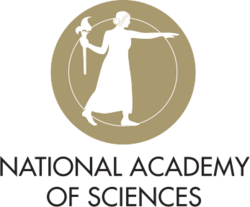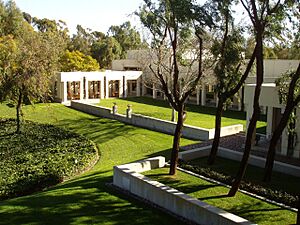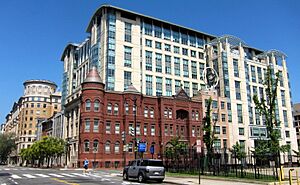National Academy of Sciences facts for kids
 |
|

The National Academy of Sciences building in Washington, D.C. in 2000
|
|
| Formation | March 3, 1863 |
|---|---|
| Founders | Alexander Dallas Bache Abraham Lincoln |
| Founded at | 2101 Constitution Avenue, NW, Washington, D.C., U.S. 20418 |
| Type | NGO |
|
Parent organization
|
National Academies of Sciences, Engineering, and Medicine |
| Endowment | $553.9 million (2020) |
The National Academy of Sciences (NAS) is a special group in the United States. It's a non-profit organization, meaning it doesn't aim to make money. The NAS is part of a bigger family called the National Academies of Sciences, Engineering, and Medicine. This family also includes the National Academy of Engineering (NAE) and the National Academy of Medicine (NAM).
Scientists who have done amazing research are chosen to join the NAS each year. Being elected is one of the biggest honors for a scientist in the U.S. Members of the NAS volunteer their time to give advice to the country. They share their knowledge on science, engineering, and medicine. The U.S. Congress officially created this group in 1863.
President Abraham Lincoln signed a law in 1863 to create the National Academy of Sciences. It was set up as an independent group. Its main goal was to give "independent, objective advice to the nation on matters related to science and technology." This meant the NAS would help any part of the government that asked for scientific advice. The academy does not get paid by the government for its services.
Contents
What the NAS Does
The National Academy of Sciences is a very important group for science in the U.S. It helps the government make smart decisions based on scientific facts.
Members and Their Role
As of 2024, the National Academy of Sciences has 2,687 members from the U.S. and 531 international members. About 1,100 people worked for the academy in 2005. Many members, around 190, have even won a Nobel Prize.
The NAS is part of a larger group called the International Science Council (ISC). The academy is led by a Council of 17 members. These members are elected from within the academy. Most of the academy's activities, about 85%, are paid for by the U.S. government. Other money comes from state governments, private groups, and businesses.
The NAS holds a meeting every year in Washington, D.C. The things discussed at these meetings are written down in its scientific journal, the Proceedings of the National Academy of Sciences (PNAS). The National Academies Press publishes over 5,000 books and reports. Many of these are available for free online.
From 2004 to 2017, the NAS also ran the Marian Koshland Science Museum. This museum had exhibits and programs for the public. It focused on topics like climate change and infectious disease. In 2017, the museum closed. A new science outreach program called LabX took its place.
How the NAS Started
President Abraham Lincoln signed the law that created the National Academy of Sciences on March 3, 1863. This law also named 50 first members. Many of these first members were scientists from the Cambridge, Massachusetts area.
In 1863, a few key people helped set up the NAS. These included Alexander Dallas Bache, Charles Henry Davis (an astronomer), and Swiss-American geologist Louis Agassiz. They worked together to plan how the academy would be formed. Senator Henry Wilson of Massachusetts helped get the bill passed in Congress.
The bill was introduced very quickly during the last hours of a Senate session. Both the Senate and the House of Representatives approved it without much discussion. President Lincoln then signed it into law.
Even though it was a big step for science in America, the creation of the NAS caused some disagreements among scientists at the time. The law stated that the academy would "investigate, examine, experiment, and report upon any subject of science or art" when asked by the government. The government would pay for the costs of these studies, but the academy itself would not get paid for its services.
Being elected to the National Academy became a very high honor for American scientists. This was true until the Nobel Prize was created later in the 1800s. In 1870, the rule about how many members the academy could have was removed.
In 2013, astrophysicist Neil deGrasse Tyson spoke about the 150th anniversary of the Gettysburg Address. He pointed out that one of Lincoln's greatest achievements was creating the NAS in the same year. This helped set the U.S. on a path where science guides government decisions.
Who Are the Members?
The academy currently has 6,892 members, including international ones, both past and present. About 3,218 of them are living today. Current members choose new members for life. Up to 120 new U.S. members and up to 30 new international members can be elected each year.
The election process starts with a nomination. Then, candidates are carefully reviewed. The final vote happens at the academy's annual meeting in April. Members belong to one of six main scientific areas, such as Physical and Mathematical Sciences or Biological Sciences.
Many members of the NAS are connected to top universities. Harvard University has had the most members overall (331). The University of California at Berkeley has had the most members (255) if you don't count medical schools. The top ten institutions, including several from the University of California System and the Ivy League, account for almost 28% of all members ever elected.
Where the NAS Is Located

The National Academy of Sciences has several buildings across the United States. The main National Academy of Sciences Building is in Washington, D.C. It's located on the National Mall. This building has a beautiful neoclassical style and was finished in 1924. It is listed on the National Register of Historic Places.
The building is used for talks, meetings, art shows, and concerts. The annual meetings of the NAS and its sister academies (NAE and NAM) are also held here. About 150 staff members work in this building. In 2012, it reopened after a big two-year restoration project. This project made the building better and more accessible.
More than 1,000 staff members work at The Keck Center of the National Academies in Washington, D.C. This center has meeting spaces and a bookstore.
The NAS also has conference centers in California and Massachusetts. The Arnold and Mabel Beckman Center is in Irvine, California. The J. Erik Jonsson Conference Center is in Woods Hole, Massachusetts.
Leaders of the NAS
The president is the main leader of the academy. They are elected by the members for a term of up to six years. They can be re-elected for a second term. Terms usually start on July 1 and end on June 30.
The academy has had 22 presidents since it began. The current president is geophysicist Marcia K. McNutt. She is the first woman to hold this important position. Her term ends on June 30, 2026.
| No. | Image | President | Term |
|---|---|---|---|
| 1 |  |
Alexander Dallas Bache | 1863–1867 |
| 2 |  |
Joseph Henry | 1868–1878 |
| 3 |  |
William Barton Rogers | 1879–1882 |
| 4 |  |
Othniel Charles Marsh | 1883–1895 |
| 5 |  |
Wolcott Gibbs | 1895–1900 |
| 6 |  |
Alexander Agassiz | 1901–1907 |
| 7 |  |
Ira Remsen | 1907–1913 |
| 8 |  |
William Henry Welch | 1913–1917 |
| 9 |  |
Charles Doolittle Walcott | 1917–1923 |
| 10 |  |
Albert Abraham Michelson | 1923–1927 |
| 11 |  |
Thomas Hunt Morgan | 1927–1931 |
| 12 |  |
William Wallace Campbell | 1931–1935 |
| 13 |  |
Frank Rattray Lillie | 1935–1939 |
| 14 |  |
Frank Baldwin Jewett | 1939–1947 |
| 15 |  |
Alfred Newton Richards | 1947–1950 |
| 16 |  |
Detlev Wulf Bronk | 1950–1962 |
| 17 | Frederick Seitz | 1962–1969 | |
| 18 | Philip Handler | 1969–1981 | |
| 19 |  |
Frank Press | 1981–1993 |
| 20 |  |
Bruce Michael Alberts | 1993–2005 |
| 21 |  |
Ralph J. Cicerone | 2005–2016 |
| 22 |  |
Marcia McNutt | 2016–present |
Awards and Recognition
The National Academy of Sciences gives out many different awards to recognize great achievements in science.
Types of Awards
- General Awards
- Membership of the National Academy of Sciences (this is an honor itself)
- Public Welfare Medal (for using science for public good)
- Science Field Awards
- Astronomy/Astrophysics: Awards like the Henry Draper Medal
- Behavioral/Social Sciences: Awards like the Atkinson Prize
- Biology and Medicine: Awards like the NAS Award in Molecular Biology
- Chemistry: Awards like the NAS Award in Chemical Sciences
- Earth and Environmental Sciences: Awards like the Alexander Agassiz Medal
- Engineering and Applied Sciences: Awards like the Gibbs Brothers Medal
- Mathematics and Computer Science: The NAS Award in Mathematics
- Physics: Awards like the Comstock Prize in Physics
NAS and Climate Change
The National Academy of Sciences plays a role in discussing important global issues like climate change.
Working Together on Climate Change
In 2005, the science academies from the G8 countries (like the U.S.) and other big countries like Brazil, China, and India signed a statement. This statement said that scientists understand climate change well enough that countries should act quickly.
In 2010, 255 members of the Academy signed a letter in Science magazine. They spoke out against attacks on climate change scientists. This was in response to a legal request for documents from a climate researcher. The researcher had already been cleared of any wrongdoing.
Notable Members and Milestones
The NAS has had many important members throughout its history.
- 1873: Edward C. Pickering was the youngest scientist ever elected.
- 1924: Florence R. Sabin was the first woman elected as a lifetime member.
- 1965: David Blackwell was the first African-American elected.
- 2013: Ben Barres was the first openly transgender scientist elected.
See also
 In Spanish: Academia Nacional de Ciencias (Estados Unidos) para niños
In Spanish: Academia Nacional de Ciencias (Estados Unidos) para niños
- American Academy of Arts and Sciences
- List of members of the National Academy of Sciences
- National Academies of Sciences, Engineering, and Medicine
- National Science Foundation (NSF)


